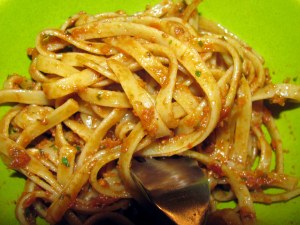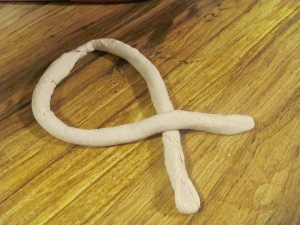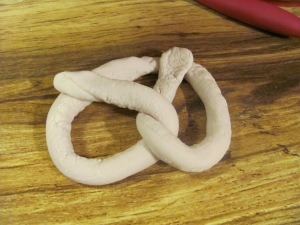
Today I woke up with an abundance of energy and excitement. It was my first day in months that I would have a real day off, a day off from the restaurant as well as a day with no school work to be done. Of course, it was also the start of the culinary lottery. So after waking up later than I had been able to in weeks, having sex with my girlfriend (of which it also felt like it had been weeks), it was time to get cooking.
I turned my attention to my crafted “lottery machine.” By lottery machine, I of course mean a cardboard box filled with 144 ping-pong balls I had numbered with a Sharpie. I cut a hole not much bigger than a ping-pong ball (and soon found out it needed to be bigger) and taped a printed list of the 144 ingredients. So as my girlfriend looked on, I gave the box a shake (and damn ping-pong balls are so noisy) and tipped the box over to reveal the first ingredient of my quest.
The ball hit my hand, the starting point of 144 meals, the start of what I hoped to be a wonderful culinary experiment, brimmed with delicious meals, culinary creativity, and wonderful times and memories with those I would share the meals with. And it all started with this first number, the number 2. My eyes quickly shifted over to my reference list where they found the number 2.
2. Molasses
Molasses? Shit. Of all the savory herbs, meats, seafood, vegetables, and condiments I had to start with something sweet? And not just a sweet food such as an apple or banana, but molasses which is essentially a sweetener. Well, I had purposely put some items on the list which I knew would be somewhat difficult to make the star ingredient of a dish. I did this with purpose, I did it for the challenge, but to start with an ingredient like molasses would not be the easiest ingredient for sure.
Oh sure, If I were a baker drawing molasses would be no problem. Gingerbread, Boston Brown Bread, spiced cookies, Anadama bread, pumpkin pie, all just a small number of the amount of baked goods that incorporate molasses. But the simple fact is, I’m not a baker.
And this is not to say I don’t like molasses. In fact, it is an ingredient I love. Add some sweetness as well as deep, rich, slightly smoky, almost malt-like flavor? Yes, I do love molasses. But I surmised making it the star of a dish might prove to be a bit of a challenge.
Yet, one aspect I hope will last in this experiment came in to play. Because my mind was only focused on creating a dish with one particular ingredient, and every other ingredient being an afterthought, the ideas starting flashing quickly in my mind. What about a BBQ sauce? A glaze? Baked beans? Braising liquid? Ah, yes. Not letting the mind wander to a vast amount of ingredients allows it to be more decisive.
I liked the idea of either a glaze or a braising liquid. The question is, what protein would I use said glaze or braising liquid with? I had a few ideas, so I decided to just go to local meat market and see where that led my thoughts.
I immediately shuffled over to the pork section, Pork and molasses being wonderful together. But then again, what about a nice demi-glace with molasses on a seared steak? Hmm. As I stood there scanning my eyes caught what was once easily my favorite protein, but now was one I ate so rarely I couldn’t remember the last time I had eaten them. Yet, as soon my eyes caught them, I knew; Baby back ribs.
For a large portion of my years, particularly my early and mid teenage years, I believed I would never grow tired of baby back ribs. Tender, smoky, fatty, ever so slightly chewy, and as all things pork go, absolutely delicious. But then I secured my first job in a restaurant (like most cooks I started at the age of 16 as a dishwasher) and my first job as a cook, both in BBQ restaurants.
Now, BBQ may be something that is held sacred by people, and one of the simplest food pleasures there is. Take a usually tough piece of meat, season it will a bevy of spices, and smoke it for a long period of time until it is deliciously smoky and tender. It doesn’t get much simpler or more delicious than that. However, 2 years in BBQ restaurants rendered BBQ almost utterly inedible for me.
The reason is simple; BBQ’s most appealing factor is the smokiness of the meats. In order to impart this flavor, one must utilize smoke (just in case you were wondering). But one aspect of smoke that is not so pleasant is being surrounded by it…constantly. So at my tenure at the second restaurant I worked for, I began to despise that hickory smoke that just a few years prior would have caused my saliva glands to go into hyperactive mode, sometimes so much that a deep breath could drown me. But after working open to close 6 days a week for months on end, this smoke not only became an un-savory scent, but also a scent I couldn’t escape. It seeped into every fiber of clothing I wore to the restaurant, even my socks. And no amount of washing could negate the smoky scent. You could pull a load of clothes from the washer, put them into the dryer, immediately take them out and they would smell more like smoke than detergent. I despised it. Because of this, only until about a year or two ago (approximately 5 years removed from the BBQ restaurants) I still could not bring myself to eat BBQ of any sort.
However, I can happily say I know have rekindled my passion for all things smoked. But, seeing as how I don’t have a smoker, and want to be able to directly control a low temperature (which would be extremely difficult with a typical charcoal grill) I decided that I would forego the smoke and braise the ribs. This of course would also enable me to better utilize the molasses.
One aspect of cooking pork ribs that so few people are able to get right is not the cooking time, the cooking process, or even the flavorings. In fact, what they usually get wrong for tender ribs that pull easily from the bone is perhaps the most simplistic step in cooking pork ribs-removing the silver-skin, the tough membrane that covers the concave portion of the ribs. Some people may be proponents of leaving the silver-skin on, but if my cooking of thousands of racks of ribs has served me justice, I have found that removal of the silver-skin is imperative. Generally speaking, if you do not remove the silver-skin, your left with a basically inedible rubbery layer that feels as if you’re trying to chew through ribs that have had latex gloves melted onto them. That just doesn’t sound appealing to me.
Many people (including a friend of mine) do not remove the silver-skin because, in their words, “It’s fucking impossible!” Well, some baby backs and St. Louis ribs tend to hold on to their silver-skin as if they were a 16 year old newly deflowered girl hanging on to their first lay, but the silver-skin on most racks can be removed so long as you use the right technique. I generally have no problems using this technique-
- Slide the blade of a pairing knife under the second to last bone of the smaller (more curved) side of the ribs, allowing the knife to follow the curve of the bone. Once you have reached about ¾ to 1 inch under the silver-skin, turn the tip of the knife into the bone, allowing the silver-skin to be raised from the bone.
- Remove the knife and repeat step one on the last bone on the same side of the ribs.
- Work your fingers under the silver-skin that you just raised with the knife. Work your fingers to the far end of the other side of the bone.
- Turn your hand, still grabbing the silver-skin, parallel and over the top of the ribs. The silver-skin will generally be removed in one swipe. If not, it will usually go about halfway to ¾ of the way. Repeat the process where the silver-skin still remains.
I had decided to dry rub these ribs before braising, and brown sugar is, of course, a vital ingredient to a dry rub. Although I usually keep brown sugar on hand, it’s not really necessary as long as you have molasses and granulated sugar. In order to make brown sugar (and the proportions aren’t exact and frankly don’t need to be), combine approximately 2/3 of a cup of granulated sugar with 2 tbsp of molasses and blitz in a food processor and you have brown sugar.

I busted out my spice tub and homemade brown sugar and made a dry rub. I let the ribs sit in the fridge for 1 ½ hours after seasoning to lets the spices start to go to work. Adding the aromatics, beer (of which I surprisingly didn’t drink most of before adding), and molasses made for an already pretty tasty smelling dish. 3 hours later, I would see how they turned out.
Day one, dish one. The verdict? These ribs were wonderful. They were tender, juicy, sweet, sticky, and packed with flavor. But now the true verdict-did this concoction highlight the molasses? The truth is, not really. But there was an undeniable sweetness, both naturally from the ribs as well as the molasses directly on the ribs, as well as the tangy, sweet sauce made from the braising liquid. So the molasses may not have been the conductor, but it was certainly a first chair. Overall, I’m very happy with how this dish turned out, not to mention very full.
1 dish down, 143 to go.

Guinness and Molasses Braised Baby Back Ribs
-2 racks of baby back ribs
-2 14.9 oz cans of Guinness Draught
-3 tbs molasses
-1 yellow onion, half-mooned
-4 ribs of celery with leaves, rough chopped
-4 cloves garlic, crushed
-1 pt. beef stock
-Spice mixture as follows-
-2/3 cup granulated sugar
-1 ½ tbsp molasses
-1 ½ tbsp smoked paprika
-1 ½ tbsp kosher salt
-1 tbsp granulate garlic
-1 tbsp ground mustard
-1 tbsp black pepper
-1 tsp dried thyme
-1 tsp cayenne pepper
-1/2 tsp oregano
-1/4 tsp ground cumin
-pinch red pepper flakes
Remove the silver-skin of the ribs and cut into half racks. Rub the spice mixture onto the ribs and let sit in the refrigerator for 1 ½ hours. With the ribs meat side up, pour the molasses, Guinness, and stock on top of the ribs. Remove the ribs from the pan and add the celery, onions, and garlic on the bottom of the pan. Place the ribs meat side down on top of the vegetable mix. Cover pan with foil. Place in a 300 degree oven and cook until tender (about 2 ½ hours). Remove the ribs from the oven and strain approximately 2 cups of the braising liquid into a saucier. Reduce by ½ and add 1 ½ tbsp of butter, season with salt and pepper and serve over the ribs.















